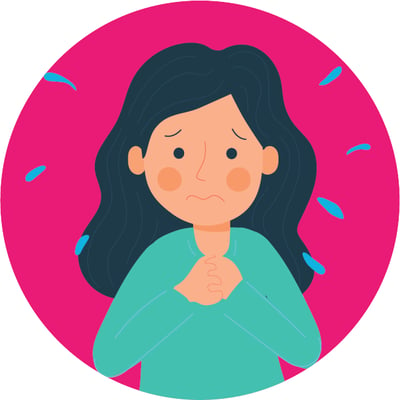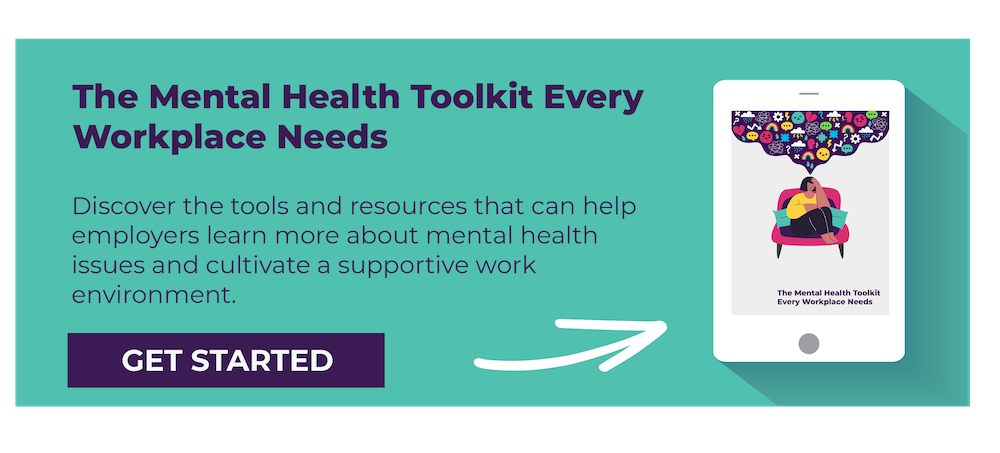Is anxiety real?
For over 40 million Americans, it’s very real. In fact, it’s the most common mental illness in the United States, according to the National Alliance on Mental Health (NAMI).
Because of this, anxiety can’t be shrugged off and labeled simply as “negative thinking” or another dismissive term. Many individuals don’t receive treatment, and when the condition is shrugged off by colleagues, friends, and employers, it can feel invalidating and cause even more anxiety.
Despite being treatable, only 36.9% of those suffering get treatment. Don’t let myths further fuel the misconceptions around anxiety disorders in your workplace.
Here’s a look at common myths about anxiety both employers and employees should know.
What is Anxiety Exactly?
Those with anxiety disorders “have intense, excessive, and persistent worry or fear about everyday situations,” according to Mayo Clinic. For some people, this coincides with regular sudden feelings of intense anxiety and fear that peak in minutes, also called panic attacks. There are several types of anxiety disorders, including separation anxiety and social anxiety, which is more common now for individuals after the pandemic.
Is Anxiety Real?
Anxiety disorders are real and serious medical conditions. Those suffering with anxiety will tell you that their worries, fears, and concerns feel very real to them, too. The side effects of anxiety can interfere with everyday life and work.
For many people, the coronavirus pandemic triggered an increase in anxiety due to the fear of catching the virus, ongoing lockdowns, isolation, and other pandemic-related issues.
Myths About Anxiety That Employers Should Know
Like other health conditions, anxiety can cause workers to experience physical and emotional issues. It can also have a major impact on individuals and their performance in the workplace.
Before shrugging off what appears to be an “invisible illness”, here’s what employers should know about anxiety and its influence on workers.
Myth #1: “Anxiety Isn’t a Real Illness”
Anxiety is as real as diabetes, high blood pressure, or heart disease. In the medical world, it is considered a legitimate illness that is also medically diagnosable. In fact, anxiety disorders are the most common mental health concern in the United States, according to the National Alliance on Mental Illness (NAMI).
Myth #2: “Anxiety Disorders Are Obvious”
While a panic attack may be an obvious sign of someone suffering from anxiety, it’s not always as visible. Sometimes, individuals may keep their anxieties under wraps due to fear of embarrassment or humiliation. Coping strategies or even simply keeping anxious thoughts quiet are ways people struggling with anxiety keep it hidden.
Myth #3: “Medication Is the Only Treatment Option”
Luckily, there are numerous ways anxiety disorders can be treated. The first step is getting a proper diagnosis from a mental health professional as there are many different disorders. Each one is different in how it may respond to treatments. Options for treatment may include talk therapy, dietary changes, breathing techniques, exercise, support groups, and medication.
Related: 4 Easy Breathing Exercises to Reduce Stress at Work
Myth #4: “Anxiety Doesn’t Impact Work Life”
This is a myth about anxiety that needs to be busted ASAP, especially by employers. Because of its powerful ability to cause mental and physical symptoms, anxiety disorders may result in short- or long-term disability. Additionally, anxiety disorders are shown to cause an average of 4.6 work days lost monthly, according to the Center for Workplace Mental Health.
Myth #5: “Anxiety is a Weakness”
While there is a lot that mental health researchers don’t know about anxiety, they are firm on one aspect: Anxiety is not a personal weakness. Researchers believe anxiety is often caused from chemical imbalances, environmental factors, or is hereditary in nature. Medical conditions and trauma are also thought to be contributing factors to anxiety disorders, according to Mayo Clinic.
Help Your Workers With Anxiety
While your employees may not always disclose their anxiety disorders to you, it’s important for them to know they can, if needed. By providing a variety of policies, resources, and open conversations, you can even alleviate their concern about talking about anxiety openly in the workplace.
Some ways to help employees with anxiety:
- Listen and act - Let them know you have an open-door policy to discuss mental health. With that policy, also offer them insight into the accommodations available as well. That may include flexible working hours, mental health days, deadline extensions, and the like. Ask them what they need and let them know how you can reasonably accommodate it.
- Understand the ADA rules - The Americans with Disabilities Act (AKA the Rehabilitation Act) protects workers with mental health conditions. Make sure you are well-versed in what’s protected and aren’t at risk of accidentally committing disability discrimination. Check out the U.S. Equal Employer Opportunity Commission website for more insight.
- Educate - Learn what you can about anxiety disorders. Share reputable materials with your team via email, bulletin boards, and meetings to open the dialogue regarding mental health conditions. Sharing information from websites like Mental Health America can also educate workers on how they can better handle the condition or if they actually may be experiencing undiagnosed anxiety.
- Develop appropriate policies and programs - How can you strengthen your wellness programs and policies to include mental health? Consider bringing in a mental health professional to review your policies to better empower your employees. Doing so can make a huge difference. In fact, 37% of employees claim employer-provided mental health resources contribute to a better work environment, according to the American Psychological Association.
Anxiety Disorder Resources For Employers
- Anxiety Disorders in the Workplace
- Anxiety Resource Center
- Anxiety and Depression Association of America (ADAA)
By better understanding anxiety and other mental health disorders, you have a leg-up on how it may impact your workers, their productivity, and the overall workplace. Left untreated, anxiety can fester and cause severe issues like insomnia, chronic pain, poor life quality, and even substance abuse issues.
While your job isn’t as a mental health professional, your role does include ensuring your employees are mentally and physically given opportunities to thrive at work. Breaking the stigma — and myths about anxiety — is just the starting point for a much deeper conversation and change.
Which myth about anxiety surprised you the most? Share your thoughts in the comments below!



